|
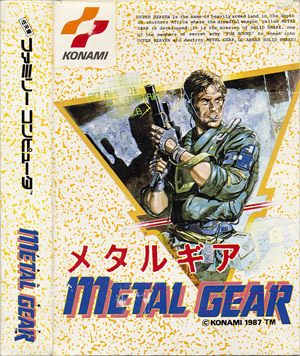
|

|
|
メタルギア
©Konami 1987
Release: 1987-12-22 (¥5300)
Cartdridge KDS-ME
Action/Stealth
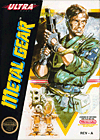

|
Released in America as
METAL GEAR
( NES-ME-USA )
|
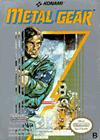

|
Released in Europe as
METAL GEAR
( NES-ME-XXX )
|
|
Metal Gear is a stealth/military action game published by Konami, and
conversion of a game originally released for the MSX 2 in 1987. In 1995,
somewhere in South Africa, the military fortress
Outer heaven is hiding a super weapon called the 'Metal Gear', formidable machine
capable of launching nuclear missiles and to strike any target in the world. A rookie infiltration
soldier codenamed Solid Snake is deployed by Foxhound, a secret special forces unit from the
western world, to locate and destroy the war machine and to find out what happened to Gray Fox, another
agent who had been sent thither before him. However, his mission comes with a
twist - he must covertly infiltrate Outer heaven and try his best to avoid direct
confrontation with his enemies. Because of the stealth nature of the game, Solid Snake
will instantly be in trouble if spotted by guards or surveillance cameras. If discovered, the
player has to leave the visited area as quickly as possible until the alert level is lifted.
He also doesn't come equipped with any weapons at first, and he must build up his arsenal along
the way and collect firearms, remote guided missiles or explosives. The game also offers a
plethora of items, such as binoculars (to explore surrounding rooms), gaz mask,
rations (to retrieve some health) and key cards that allow the player to access
certain areas that are otherwise locked and off-limits. Throughout the game, Solid Snake
is also headed by his commanding officer Big Boss - a transceiver constantly feeds the player with critical
information about Outer Heaver and the game's intricate story.
|
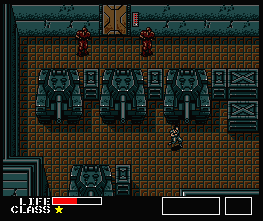 Hideo Kojima is the mind behind the critically acclaimed Metal Gear series and
its intricate story line. The first Metal Gear was released in Japan and Europe for the MSX in 1987
(picture on the right), and was later ported to the Famicom (1987), Commodore 64 (1990)
and PC-DOS (1990). However, it seems that Hideo Kojima was not directly involved in the
development of the various ports, and especially the Famicom version which was significantly
altered. Snake's Revenge followed in 1990 for the Nintendo Entertainment System (it was
exclusively released in the US and Europe) - this sequel is however not really related to the series
and Hideo Kojima wasn't part of the design and development process. The real sequel, called
Metal Gear 2: Solid Snake was exclusively released in Japan for the MSX in 1990
and takes place four years after the original game (it was later included in Metal Gear Solid 3: Subsistence
released for the Playstation 2 in 2005). The series then transitioned to 3D with
Metal Gear Solid (Playstation, 1998) which borrowed many gameplay elements from the original
Metal Gear 2. The series is still incredibly strong and many sequels
followed - Metal Gear Solid 2: Sons of Liberty (Playstation 2, 2001),
Metal Gear Solid 3: Snake Eater (Playstation 2, 2004),
Metal Gear Solid: Portable Ops (Playstation Portable, 2006),
Metal Gear Solid 4: Guns of the Patriots (Playstation 2, 2008) and
Metal Gear Solid: Peace Walker (Playstation Portable, 2010). Several
spin-offs, remakes and extended versions also exist, such as Metal Gear: Ghost Babel (GameBoy Advance, 2000),
Metal Gear Solid 2: Substance (Playstation 2, 2002),
Metal Gear Solid : The Twin Snakes (Game Cube, 2004),
Metal Gear Acid (Playstation portable, 2004)
and Metal Gear Solid 3: Subsistence (Playstation 2, 2005).
Hideo Kojima is the mind behind the critically acclaimed Metal Gear series and
its intricate story line. The first Metal Gear was released in Japan and Europe for the MSX in 1987
(picture on the right), and was later ported to the Famicom (1987), Commodore 64 (1990)
and PC-DOS (1990). However, it seems that Hideo Kojima was not directly involved in the
development of the various ports, and especially the Famicom version which was significantly
altered. Snake's Revenge followed in 1990 for the Nintendo Entertainment System (it was
exclusively released in the US and Europe) - this sequel is however not really related to the series
and Hideo Kojima wasn't part of the design and development process. The real sequel, called
Metal Gear 2: Solid Snake was exclusively released in Japan for the MSX in 1990
and takes place four years after the original game (it was later included in Metal Gear Solid 3: Subsistence
released for the Playstation 2 in 2005). The series then transitioned to 3D with
Metal Gear Solid (Playstation, 1998) which borrowed many gameplay elements from the original
Metal Gear 2. The series is still incredibly strong and many sequels
followed - Metal Gear Solid 2: Sons of Liberty (Playstation 2, 2001),
Metal Gear Solid 3: Snake Eater (Playstation 2, 2004),
Metal Gear Solid: Portable Ops (Playstation Portable, 2006),
Metal Gear Solid 4: Guns of the Patriots (Playstation 2, 2008) and
Metal Gear Solid: Peace Walker (Playstation Portable, 2010). Several
spin-offs, remakes and extended versions also exist, such as Metal Gear: Ghost Babel (GameBoy Advance, 2000),
Metal Gear Solid 2: Substance (Playstation 2, 2002),
Metal Gear Solid : The Twin Snakes (Game Cube, 2004),
Metal Gear Acid (Playstation portable, 2004)
and Metal Gear Solid 3: Subsistence (Playstation 2, 2005).
|
|
There are several differences between the Famicom port of Metal Gear
(version tested here) and the original MSX version. The beginning of the game is
totally different - in the Famicom version, Solid Snake parachutes into a
maze-like jungle area, whereas he directly infiltrates the enemy building in the MSX
version and deploys by sea. The Famicom game is overall a lot more difficult, some
buildings have been shuffled around as well as items and weapons, and some events are a lot more random - trucks
transport the player from one location to another, and the jungle phase loops in many places.
Enemies could also track the player down beyond the visited screen and this feature was removed
from the Famicom port. The most notable difference is also the underlying goal of the
game - players had to battle the Metal Gear itself at the end of the MSX version,
whereas they had to destroy a Super Computer which controls the Metal Gear
in the Famicom port. Finally, in the North American and European versions,
many of the character names were changed - Big Boss
became Commander South, and the enigmatic leader of the Outer heaven secret
army was given the spoof name 'Vermon CaTaffy' (pun on Lybian leader Muammar Al-Qaddafi)
- the story in the game's manual was deeply altered,
Konami's Ultra publishing company took considerable (and rather childish) liberties with the original Japanese source
material, where Vermon Cataffy is described as "a once tranquil shepard boy, who grew up on the
remote banks of the Sam Sam River in outer Mongolia with his 27 sisters,
turned to terrorism at an early age"... What were they thinking ?
|
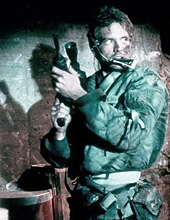 Hideo Kojima, the Metal Gear series' designer and one of the
most influential figures in the video game industry, is an avowed action movie
fan, and countless references to '80s/'90s Hollywood movies can be found in his work.
Hideo Kojima confirmed in an interview that the character Snake was inspired by Snake
Plissken (Kurt Russel) from John Carpenter's Escape from New York (1981).
In Metal Gear Solid 2, Snake chooses Iroquois Pliskin
as an alias name, and one of the possible origins of the name Iroquois
was a french transliteration of a native American name that meant 'adder'
or 'Black Snake'.
Hideo Kojima, the Metal Gear series' designer and one of the
most influential figures in the video game industry, is an avowed action movie
fan, and countless references to '80s/'90s Hollywood movies can be found in his work.
Hideo Kojima confirmed in an interview that the character Snake was inspired by Snake
Plissken (Kurt Russel) from John Carpenter's Escape from New York (1981).
In Metal Gear Solid 2, Snake chooses Iroquois Pliskin
as an alias name, and one of the possible origins of the name Iroquois
was a french transliteration of a native American name that meant 'adder'
or 'Black Snake'.
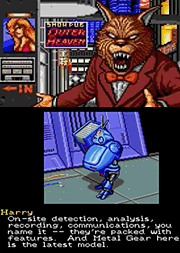 Metal Gear cover art is also most likely inspired by
the character Kyle Reese (Michael Biehn, picture on the left) from James Cameron's Terminator (1984) - well, it
wasn't uncommon for Konami to follow such practice in the '90s.
Most of the characters from Metal Gear 2 were also based on
popular celebrities such as Mel Gibson, Dolph Lundgren and
Sean Connery. Finally, Metal Gear is referenced in
other games designed by Hideo Kojima - in Snatcher, the little navigator
robot who follows Gillian Seed is called 'Metal Gear Mk.II' (it will
also appear in Metal Gear Solid 4), and Outer Heaven is the name
of a night club in the game (picture on the right). In Policenauts, another cinematic adventure
game by Hideo Kojima, the character Meryl Silverburg is a member
of the special forces unit Foxhound, and inspired the character of the same
name from Metal Gear Solid, and a bar called the 'Solid Snake' can
be seen in the game.
Metal Gear cover art is also most likely inspired by
the character Kyle Reese (Michael Biehn, picture on the left) from James Cameron's Terminator (1984) - well, it
wasn't uncommon for Konami to follow such practice in the '90s.
Most of the characters from Metal Gear 2 were also based on
popular celebrities such as Mel Gibson, Dolph Lundgren and
Sean Connery. Finally, Metal Gear is referenced in
other games designed by Hideo Kojima - in Snatcher, the little navigator
robot who follows Gillian Seed is called 'Metal Gear Mk.II' (it will
also appear in Metal Gear Solid 4), and Outer Heaven is the name
of a night club in the game (picture on the right). In Policenauts, another cinematic adventure
game by Hideo Kojima, the character Meryl Silverburg is a member
of the special forces unit Foxhound, and inspired the character of the same
name from Metal Gear Solid, and a bar called the 'Solid Snake' can
be seen in the game.
|
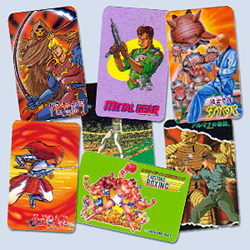 Like several other early Konami games released in the 1980s/1990s, Metal Gear
included a numbered collector card also known in Japan as コナミ キャラカード (aka 'Konami Chara Cards' or 'Konami Character Cards').
Each card featured an illustration or a snapshot
from the game (picture on the right), and the back of each card showed a serial number as well as the
game's title. They were randomly included with the games and Konami
produced several variations of each card. That's it, each game included a
card from a series related to the game, it is however not known
how many different card variations were made for each game.
Apparently six cards (on average) were produced for each game, except
for Doremikko (1 card), Exciting Boxing (1 card) and Meikyujin Dababa
(which, curiously, only seem to feature five cards).
The list of
Konami games to include such cards are believed to be :
Ai Senshi Nicol (FDS),
Dracula II Noroi no Fuin (FDS),
Arumana no Kiseki (FDS),
Contra (FC),
Doremikko (FDS),
Dragon Scroll (FC),
Exciting Baseball (FDS),
Exciting Basketball (FDS),
Exciting Billard (FDS),
Exciting Boxing (FDS),
Exciting Soccer (FDS),
Falsion (FDS),
Getsu Fūma Den (FC),
Majō Densetsu II Daimashikyō Galious(FC),
Meikyū Jiin Dababa (FDS),
Metal Gear (FC),
Salamander (FC),
Tetsuwan Atom (FC),
Top Gun (FC)
and Wai Wai World (FC).
Like several other early Konami games released in the 1980s/1990s, Metal Gear
included a numbered collector card also known in Japan as コナミ キャラカード (aka 'Konami Chara Cards' or 'Konami Character Cards').
Each card featured an illustration or a snapshot
from the game (picture on the right), and the back of each card showed a serial number as well as the
game's title. They were randomly included with the games and Konami
produced several variations of each card. That's it, each game included a
card from a series related to the game, it is however not known
how many different card variations were made for each game.
Apparently six cards (on average) were produced for each game, except
for Doremikko (1 card), Exciting Boxing (1 card) and Meikyujin Dababa
(which, curiously, only seem to feature five cards).
The list of
Konami games to include such cards are believed to be :
Ai Senshi Nicol (FDS),
Dracula II Noroi no Fuin (FDS),
Arumana no Kiseki (FDS),
Contra (FC),
Doremikko (FDS),
Dragon Scroll (FC),
Exciting Baseball (FDS),
Exciting Basketball (FDS),
Exciting Billard (FDS),
Exciting Boxing (FDS),
Exciting Soccer (FDS),
Falsion (FDS),
Getsu Fūma Den (FC),
Majō Densetsu II Daimashikyō Galious(FC),
Meikyū Jiin Dababa (FDS),
Metal Gear (FC),
Salamander (FC),
Tetsuwan Atom (FC),
Top Gun (FC)
and Wai Wai World (FC).
|
Teaser text copied from the American version:
Crazed colonel Vermon
Cataffy poses new terrorist
threat to the world.
Outer Heaven leader Ca Taffy has activated
the ultimate super weapon: Metal Gear!
Responding to the crisis, covert unit
"Fox Hound" is called into action, and that's
where you come into play.
Trained in hand-to-hand combat and
skilled in every weapon known to man,
you're Fox Hound's lethal fighting
machine, code named "Solid Snake".
But on this mission you better be sly
as well, to surprise heavily armed
enemies, busting'em up quietly and
rescuing their hostages before alarms
are triggered.
Plus you gotta maintain radio
contact with Commander South,
who'll feed you crucial info on
Metal Gear's whereabouts.
To survive, capture sub-machine
guns, Barettas,
grenade launchers, and plastic
explosives...
Until you find and destroy
Metal gear, ending Ca Taffy's
reign of terror.
|
Game Staff (Copied from the end credits) :
|
Main Program
Yoshihiro Sugimoto
|
|
Sub Program
Masahiro Ueno
Graphic Design
Conpagno Ogikubo
|
|
Sound Effect
Kazuki Muraoka
|
|
Presented by
Konami
1987 Tokyo
|
|
G
O
O
D
I
E
S
|
|
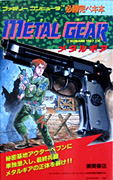
Japanese Guidebook
|
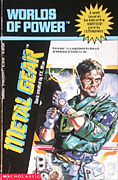
American Novel Book
|
|
|
O
M
A
K
E
|
|
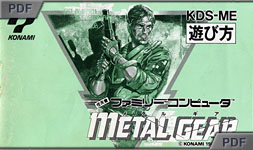
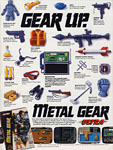
|
|
|
Click on picture to enlarge |
S
E
C
R
E
T
S
|
|
Alert level glitch:
When the alarm goes on, just switch to the equipment screen and equip the binoculars to
lift the alert level.
Ammo and rations:
Weapons ammo and rations don't disappear once they have been collected. Keep entering
and exiting a truck/room for a complete refill. You can also switch to the transceiver
screen to reset the items in a room.
|
|
Class/Rank:
This is not really a secret, but this part of the game is rather obscure.
The rank/class increases as you rescue prisoners/hostages. The number of
stars influences your maximum life, ammo and rations. But most importantly, it
affects checkpoints and where you start the game after you continue :
☆ Jungle
☆☆ First building
☆☆☆ First building's elevator
☆☆☆☆ Back of the first building
|
|
|
|
LK

|
|
Add your Pov here !
|
P
O
V
s
|
|
The Metal Gear series is legendary, and this first episode features many of
the unique gameplay mechanics that have made the series a cult hit (it merits mentioning that
I am a diehard fan of the series). The stealth nature
of the game is, I think, plain genius and gives the game (and the series) a realistic look
and feel not found on any action shooters at the time (and even rarely today). However,
Hideo Kojima wasn't directly involved with this Famicom port, and the game
doesn't live up to the standards of the MSX original. It is overall a lot more
difficult and poised with a few annoying gameplay flaws - such as frustrating checkpoints,
random mazes and a questionable equipment system (having to unequip the gaz mask in order
to use a keycard being the worst offender). Although the MSX version
was a much better game overall, this Famicom port is still a finely crafted and
excellent conversion.
|
|
|
|